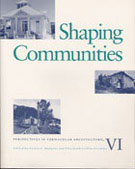Shaping Communities
Perspectives in Vernacular Architecture, VI

- Author(s): Hudgins, Carter L., and Elizabeth Collins Cromley, eds.
- Series: Perspectives in Vernacular Architecture
- Imprint: Univ Tennessee Press
- Publication Date: 1997-04-04
- Status: Active
- Available in Paper: Price $30.00 | Buy Now
This volume brings together nineteen essays from an array of academic disciplines—American studies, folklore, history, architectural history, and architecture—which are currently contributing to the study of vernacular structures and places. Addressing places as distant from each other as rural Massachusetts and Hawai‘i and building types as disparate as Native American houses in Alaska and vacation cottages in Florida, the contributors are unified in their concern with community building and place making.
As the editors note, scholarship on vernacular forms once focused rather narrowly on individual buildings and building types—an emphasis that has since given way to broader explorations. Accordingly, these essays reflect the ever-growing interest of vernacular architecture studies in the role building plays in defining communities, how building shapes the discourse between individuals and the society and culture of which they are a part, and how building conveys a community’s sense of itself.
The essays are grouped into four sections. In “Communities Shaped by Ideals,” the contributors examine how the particular ideals and aspirations of a community contribute to the forms its buildings take. The essays in “Community Landscapes” focus on shared spaces, such as parks and streets, while the essays in “Communities Shaped by Race and Ethnicity” examine the contributions of specific ethnic groups to building traditions and the impact of architecture on group identity. Finally, in “Communities Shaped by Commerce,” the writers investigate the impact of commercial culture on building designs and civic activity.
Fascinating in their many implications, the essays in Shaping Communities offer cutting-edge analysis of the ways in which the various and often competing strands of a culture are deployed and resolved in the built environment.
The Editors: Carter L. Hudgins is executive director of the Historic Charleston Foundation. Elizabeth Collins Cromley heads the School of Architecture at the State University of New York at Buffalo.
